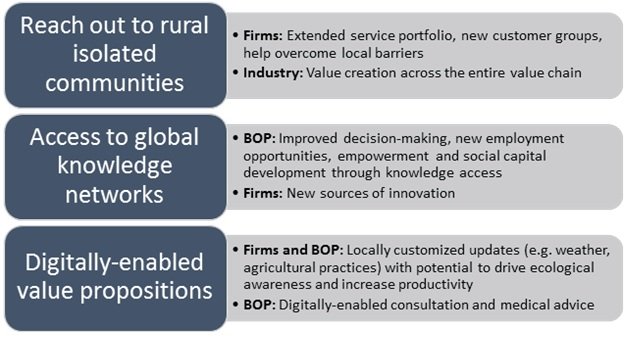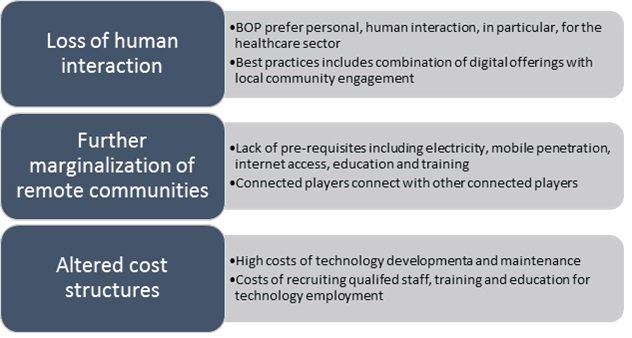 )
)
With increasing interest in digitalization in Western economies one question arises: How may digital technologies reach out and have a transformative role in developing economies to address societal challenges of fundamental nature? Dr. Eugenia Rosca and her colleagues at Jacobs University, Bremen, Germany, set out to explore this question and conducted several studies in an attempt to map contributions and limitations of digitalization for inclusive business efforts in Base of the Pyramid (BOP) markets. On the empowering people. Blog she summarizes several preliminary insights.
Contributions
Firstly, digitalization has the potential to contribute to ending the state of rural isolation. This is especially important for the healthcare sector where by leveraging high-speed internet and mobile technology infrastructure, rural remote communities can benefit from low-cost consultation and diagnostic facilities. Digital technologies can enable companies to expand their service portfolio without significantly altering their current cost structures. This can be seen in the case of e-healthcare providers Sevamob or iKure, where offerings for diagnoses and treatments are also considerably cheaper than conventional ones. Digitalization in the market for healthcare services enables improved performance measurement through data collection and aggregation. For example, Sevamob produces statistics about disease prevalence. This data can improve current processes by enabling local doctors to specialize in certain diseases and regional hospitals could provide more of the material in need such as vaccinations to prevent the spreading of these diseases. In low-income settings, cost-efficient digital technology can help overcome local barriers related to infrastructure, telecommunication and power shortages. For example, the use of digital technologies enables Mimosa TEK to reach a large number of farmers in remote areas because data processing takes place through cloud system. By providing new approaches to overcome local constraints, digital business models create value not only for local BOP and the firms, but for a wider range of actors across the value chain, in agriculture or healthcare.

Secondly, digital technologies can provide improved access to knowledge and enable better-informed decision-making for the BOP. Digitalization in low-income markets is supposed to facilitate better business transaction decisions and “close the knowledge gap small scale producers have with respect to their price fixing mechanisms, risk hedging and direct trade with responsible buyers around the globe”. Moreover, providing information and access to knowledge in remote locations enables a two-way exchange between the companies and their consumers. As such, information empowerment of BOP can further function as a source of innovation for new products as the firm acquires new information about the farmers’ needs and buying behavior.
Thirdly, digital technologies can enable the creation and offering of new, innovative and socially transformative value propositions. For example, farmers in the case of Mimosa TEK receive regular updates on irrigation practices, fertigation solutions and greenhouse solutions. These services are not only environmentally friendly, but customized to local needs and requirements of the soil, biodiversity and plants. The case of Mimosa TEK further shows that the active involvement of the rural farmers in the data-gathering process can lead to a more conscious perception of water usage and stimulate the farmers to rethink their behavior. Therefore, environmentally friendly services and value propositions can also enhance changes of attitudes and behavior in particular in the area of sustainable lifestyle. The use of artificial intelligence enables Sevamob to provide new value propositions to both patients and doctors, namely detect fungal infections at point-of-care, web-based training, impact measurement and accurate and timely data on health outcomes. Moreover, the real time collection of medical data enables Sevamob to provide value propositions for other stakeholders (government, hospitals) through reports which show the statistics for given demographic groups in terms of prevalent diseases, symptoms and risks. Similarly, iKure’s local health teams in remote villages are equipped with data analytics tools and cooperate with partner institutions in trying to identify endemic health issues in communities and develop holistic disease prevention solution approaches which aim to prevent root-causes rather than treat symptoms. This illustrates how e-healthcare providers and digitally-enabled offerings can create value at multiple levels and points across the healthcare chain.

Risks and limitations
Firstly, our interviewed experts in BOP markets point to the danger of a loss of human interaction. It has been mentioned that “low income women want the doctor to talk to them and not computers” and digital technologies “should not replace the power of physical interaction”. Our case studies analysis reveals that especially in the healthcare sector where patients may still prefer traditional face-to-face consultations, e-healthcare providers combine digital offerings with local capacity building efforts. For example, iKure’s unique value proposition is the combination between advanced technology and trained rural community health workers which can address local social and cultural aspects. Similarly, Sevamob offers a mix of digital and traditional offerings in order to overcome the need for in-person, traditional consultation.
Secondly, the installation of digital technologies presents low-income markets with high risks as a result of the costs arising from the installment of prerequisites. These prerequisites include electricity access, mobile penetration, training and infrastructure. As a result of these high costs and poor existing infrastructure, digitalization can further marginalize low-income communities from global knowledge centers.
Open questions
While our findings do shed some light on potential contributions and risks of digitalization for BOP markets, there are still many open questions. Since the ventures in e-healthcare or digital agriculture solutions are still young, it is still not clear how successful in terms of diffusion and acceptance will such models be. In terms of impact, it is interesting to investigate specific industries and the impact digital technologies can have on entire value chain rather than only individual companies or communities. Additionally, since digital technologies may also serve as barriers for smallholder farmers or BOP in remote areas to join global networks and value chains, I am wondering to what extent do digital technologies hinder inclusion of BOP in value chains.
thank you brother
Hi! I am a robot. I just upvoted you! I found similar content that readers might be interested in:
http://blog.empowering-people-network.siemens-stiftung.org/the-role-of-digitalization-for-inclusive-business-a-recipe-for-inclusion-or-further-marginalization/